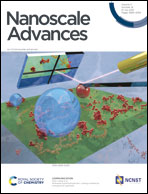Linewidth narrowing of aluminum breathing plasmon resonances in Bragg grating decorated nanodisks†
Abstract
Plasmon resonances with high-quality are of great importance in light emission control and light–matter interactions. Nevertheless, inherent ohmic and radiative losses usually hinder the plasmon performance of metallic nanostructures, especially for aluminum (Al). Here we demonstrate a Bragg grating decorated nanodisk to narrow the linewidth of breathing plasmon resonances compared with a commensurate nanodisk. Two kinds of plasmon resonant modes and the corresponding mode patterns are investigated in cathodoluminescence (CL) depending on the different electron bombardment positions, and the experimental results agree well with full wave electromagnetic simulations. Linewidth narrowing can be clearly understood using an approximated magnetic dipole model. Our results suggest a feasible mechanism for linewidth narrowing of plasmon resonances as well as pave the way for in-depth analysis and potential applications of Al plasmon systems.



 Please wait while we load your content...
Please wait while we load your content...